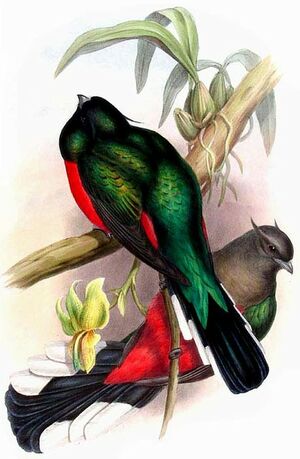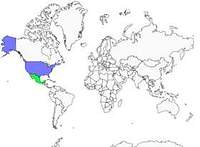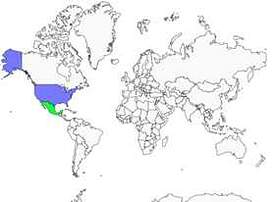Eared Quetzal
Euptilotis neoxenus - Trogon oreillard Quetzal oreillard
Identification
Is the Eared Quetzal a quetzal or a trogon, his cousin? The Anglo-Saxons have been clear and called it Eared Quetzal since 1998. Its scientific name is a source for dreams and legends, Euptilotis neoxenus, which the Hellenists would translate as 'The feather of the fabulous foreign serpent who has just arrived'. British ornithologist John Gould came up with the name Eared Quetzal in 1838, five years after the Mountain Trogon and four years after the Elegant Trogon, which cover the same area of distribution. Did he want to make it clear that it was the last trogon (or quetzal) discovered?
Measuring 35 cm, with a pronounced dimorphism, the male has coal-black parotids as well as throat and forehead. The eye is black, with a blue-gray orbital ring; behind the eye and at the level of the ears, the bird has a thin bunch of black feathers, which is an unmistakable characteristic of this trogonid and which inspired its name; the beak also has the same blue-gray color, with the upper jaw being darker at the tip.The mantle and back have a strange color, an alternating combination of bronze-green and gray, the rump and upper-tail coverts take on turquoise blue tints according to the light, the appearance of the feathers gives the impression that the bird is covered with scales; the scapulars and great coverts maintain the same aspects and colorations of bronze-green and gray, the primaries are sharply white-edged and very long. The breast is very dark green, perhaps a little lighter on the part bordering the throat, the abdomen is bright red, without a white band between the breast and the abdomen. The first pair of under-tail coverts immediately beneath the lower abdomen is black at the base, then white, the other two pairs of tail coverts are totally white and they have a vertical black line dividing the right and left sides, the tip of the tail is marked with a black horizontal line.The upper rectrices are navy-blue, and the light will also influence the color, sometimes giving a rather dull blue or a brighter shade. The tarses, which are always difficult to see, are grey.The females differ by having a head and breast that are brown-grey; the parotids are the same shade but darker. The female Eared Quetzal will also sport the same ear tufts as her mate but with a grey colour. The belly is more pink-than-red and is duller than the male's. As with many other quetzals, the juvenile looks like its mother; the head and breast are light brown, and lower rectrices are not yet the beautiful white of the adults and are greyish.
Subspecific information monotypic species
Foreign names
- Trogon oreillard,
- Trogón orejón,
- quetzal-orelhudo,
- Kieferntrogon,
- füles trogon,
- Geoorde Trogon,
- Quetzal orecchiuto,
- örontrogon,
- Øreketsal,
- kvesal uškatý,
- trogon ušatý,
- Øretrogon,
- korvatrogoni,
- quetzal orellut,
- kwezal ciemny,
- ausainais kvecals,
- Ушастый трогон,
- ミミキヌバネドリ,
- 角咬鹃,
- 角咬鵑,
Voice song and cries
A repeated whee-whuu-whuu of six to fifteen very high-pitched notes, ending in a trill - this song can be heard up to 200 meters away, and it can be similar to the first few notes of a young falcon's cry. The bird also makes "eeep-eeep-eeep" sounds, growing increasingly high-pitched. Analogy-wise, you can relate this sound to that of a child's squeaky toy. There are also alarm cries of cac-ac-ac-ac, and it is thought that the male Eared Quetzal vocalizes much more frequently than the female.
Habitat
He loves primary forests of pines, such as Pinus engelmanni (commonly known as Apache Pine) Pinus ponderosa (or Blackjack pine in Arizona). The Eared Quetzal loves high altitudes and can be found between 1 800 m and 3 000 m. It has been known to favor trees with a variety of epiphyte plants such as orchids or bromeliads.
Behaviour character trait
Normally sedentary in its habits, however, it tends to descend to sea level in autumn and winter. Juveniles may also wander sporadically.
Dietfeeding habits
The Eared Quetzal has the diet of all trogonids, being an insectivore it enjoys orthopterans, arthropods, caterpillars and various larvae. In Arizona, it has been observed indulging in berries from Arbutus arizonica, a tree of the Ericaceae family (in France, blueberries and rhododendrons are part of this family). Its diet will become mostly insectivorous when it comes to feeding its young.
Reproduction nesting
Breeding season typically starts in April and extends to October. The Eared Quetzal carves its nest in large trees, such as pine, maple, from a height of 9 to 22 meters. It will also often use old woodpecker's nests, particularly those of the Colaptes chrysoides, the golden-olive woodpecker or Melanerpes formicivorus, the acorn woodpecker. We know very little about the Eared Quetzal's breeding behavior; Kenneth Williamson, British ornithologist (1914-1977), suspected that the incubation period of Euptilotis neoxenus was very similar to that of Pharomachrus mocinno, the Resplendent Quetzal, that is, four weeks. Generally, both parents feed the two chicks. At present, there is no precise information on when the young birds leave their nests and become independent.
Geographic range
It is normally found exclusively in Mexico, in the northwest in the provinces of Sonora and Chihuahua, alongside the Sierra Madre. The Michilía Biosphere Reserve near the city of Durango is a privileged observation site. Since 1977, it has been identified in the United States, only in southern Arizona where it can be found in the Chiricahua Mountains and in the Cave Creek Canyon Reserve. The bird in question is the Eared Quetzal.
Threats - protection
IUCN conservation status
concern
in the Wild
threatened
evaluated
Birdlife estimates the population of Eared Quetzal to be between 20,000 and 50,000 individuals and has reclassified it as LC, i.e. of least concern, while the IUCN kept the NT classification, considering that deforestation could have a negative impact on the species. This splendid quetzal is a poorly known bird, rarely observed and photographed, its difficult habitat for humans being probably its best protection.
Sources of information
- IOC World Bird List (v14.1), Gill, F and D Donsker (Eds). 2024-04-18.
- A Natural history of the Trogonidae, Joseph M.Forshaw Albert Earl Gilbert
- Vol. 6 - Handbook of the Birds of the World, Josep del Hoyo-Andrew Elliott-Jordi Sargatal
- All the Birds of North America, American Bird conservancy's Field Guide
- xeno-canto, Sharing bird sounds from around the world,
- Audubon,
- Avibase, Lepage Denis
- BirdLife International, BirdLife International
- Planet of Birds,
- Neotropical Birds Online,
- Wikipédia, Wikipedia, The Free Encyclopedia
Other sources of interest
 Specification sheet created on
02/08/2023 by Anne et Gabriel Leboff
Specification sheet created on
02/08/2023 by Anne et Gabriel LeboffTranslation by AI Oiseaux.net
published: 28-07-2013 - Updated: 15-09-2013
© 1996-2024 Oiseaux.net
- Accipitriformes
- Aegotheliformes
- Anseriformes
- Apodiformes
- Apterygiformes
- Bucerotiformes
- Caprimulgiformes
- Cariamiformes
- Casuariiformes
- Charadriiformes
- Ciconiiformes
- Coliiformes
- Columbiformes
- Coraciiformes
- Cuculiformes
- Eurypygiformes
- Falconiformes
- Galliformes
- Gaviiformes
- Gruiformes
- Leptosomiformes
- Mesitornithiformes
- Musophagiformes
- Nyctibiiformes
- Opisthocomiformes
- Otidiformes
- Passeriformes
- Pelecaniformes
- Phaethontiformes
- Phoenicopteriformes
- Piciformes
- Podargiformes
- Podicipediformes
- Procellariiformes
- Psittaciformes
- Pterocliformes
- Rheiformes
- Sphenisciformes
- Steatornithiformes
- Strigiformes
- Struthioniformes
- Suliformes
- Tinamiformes
- Trogoniformes



